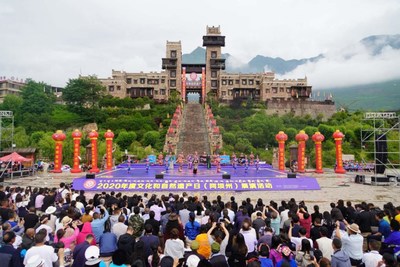- Sichuan's Aba Prefecture promotes the beauty of the area's sacred mountains and pure land, while integrating its intangible cultural heritage into today's modern lifestyle
MAOXIAN, China, June 22, 2020 /PRNewswire/ -- The tourism authorities of Aba Tibet and Qiang Autonomous Prefecture, more informally known as Aba Prefecture, an autonomous prefecture in the northwestern part of Sichuan province, presented a series of exhibitions and performances at the ancient castle near the entrance to Maoxian Qiang Ethnic scenic area in the prefecture's Mao County from June 12 to June 13, 2020, as part of China's celebrations for Cultural and Natural Heritage Day 2020.

The event held at the ancient castle near the entrance to Maoxian Qiang Ethnic scenic area in Aba Prefecture's Mao County
The event started with exhibitions and performances with a focus on Aba Prefecture's iconic intangible cultural heritage, including Tuigan and the Qiang flute. Tui Gan is a unique traditional sport favored by the Qiang ethnic group, who usually celebrate festivals, weddings and harvests with a few rounds of the popular competitive game.
Event participants gained a deeper understanding of the local intangible heritage with the presentation of several traditional musical performances featuring some of the area's most iconic folk songs, including Bang Jin Mei Duo, Da Mai Ge (the "Thrashing Wheat" song), Zhusangsang (the last being a folk song of the Tibetan minority located in the western part of Sichuan Province) and other polyphonic Qiang songs, as well as Sheepskin Drum Dance and other dances meant to celebrate the annual harvest as well as the Waerezu and Qiang New Year festivals.
The event boosted visitor engagement by combining online and offline experiences at Sha Lang Square, another locale within the scenic area. Members of the local community who were designated as inheritors showcased 16 traditional handicrafts and instruments that form part of the area's intangible cultural heritage, including several examples of Tibetan Cross-Stitch Embroidery, Qiang Embroidery and the Qiang flute. The exhibitions were also live streamed on Taobao.com by individual podcasters, online influencers and intangible cultural heritage inheritors in a move to promote sales of the items displayed.
Intangible cultural heritage inheritor Namu Gesang gave an onsite presentation on the topic of Tibetan Cross-Stitch Embroidery. She had been interested in local crafts since childhood and learned the traditional skill from her mother and grandmother. The Tibetan embroidery handicrafts that she made are now available throughout China. She said, "As an ancestral handicraft technique, it must and will continue to be passed down. These crafts are 100% made by hand and incorporate traditional Tibetan knitting and embroidery elements enhanced by traditional color and pattern designs."
Lang Xing, director of intangible cultural heritage at the Aba Tibet and Qiang Autonomous Prefecture Bureau of Culture, Sports and Tourism, said, "Traditional handicrafts and instruments unique to Aba Prefecture have been registered by the responsible authorities as intangible cultural heritage items, include 19 items at the national level, 73 at the provincial level, 457 at the prefectural level and over 800 at the county level. The Qiang New Year Festival has been included in the UNESCO List of Intangible Cultural Heritage in Need of Urgent Safeguarding." He indicated that Cultural and Natural Heritage Day provided the prefecture with an opportunity to further explore and protect its intangible cultural heritage. As part of the prefecture's plans to strengthen efforts on further educating the public on the importance and relevance of intangible cultural heritage, the prefecture will continue to enhance the inheritance through the application of innovative approaches backed by the integration of intangible cultural heritage and tourism resources. Additionally, Aba Prefecture plans to boost the quality-based growth of and innovation around the cultural tourism sector by leveraging the unique combination of culture and tourism as well as of tourism and intangible cultural heritage with the aim of transforming the whole of the prefecture into a leading tourism destination.